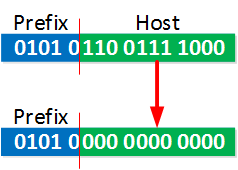This topic is to discuss the following lesson:
very simple explanation yet so informative. thank you
The best I’ve seen on this, without straying into
geeksville and losing me.
Very simple, thank you, for the explanation
One more example would’ve been nice ![]() Very useful though
Very useful though
Hey Rene,
Could you explain how we determine where to cut off the end of the prefix? (see image attached)
Hi Scott,
There’s no image ![]()
Rene
Hello Rene,
I really appreciate your explanations. they are very intuitive as well a 4 year old could understand, though at times I feel like an infant when trying to wrap my head around some of the terminology.
Appreciate the help!
Angel Acosta
Thanks Angel! My goal is to make it as simple as possible ![]()
The more time you spend at this, the easier it becomes…before you know it you feel like a guru =)
Hi Rene,
Could you please let me know how many continuous hextet of '0’s should be there to be replaced by a ‘:’.
Thank you.
Hello Srikanth.
Whenever you have two or more groups of four 0’s, you can replace them with ‘::’ So for example, if you have 2001:0db8:85a3:0000:0000:8a2e:0370:7334 it can be rewritten as 2001:0db8:85a3::8a2e:0370:7334.
If however you have only one group of four 0’s such as in 2001:db8:0000:1:1:1:1:1 it is never replaced with a :: but just with a single 0 like this: 2001:db8:0:1:1:1:1:1.
Note also that this two-colon replacement may only be applied once in an address, because multiple occurrences would create an ambiguous representation. For example, 2001:0000:0000:0000:1:0000:0000:1 could be rendered as 2001::1:0:0:1 or 2001:0:0:0:1::1 but not as 2001::1::1
I hope this has been helpful!
Laz
I approve.
I actually had a sigh of relief because this made sense and was easy to understand. Felt a bit of pride that I was able to still remember how to do Hex to Dec!!
IPV6 is a booger but this lesson was helpful with dealing with prefixes!
Beautiful EXPLAINATION thank u
Hello Mahamane
If you were to look at an IPv6 address in binary, then you can count each and every bit in the address until you get to the 53rd bit and you would know where to split the address between host and network. However, because IPv6 addresses are expressed in hexadecimal, individual bits are not visible and cannot be separated appropriately. This is because a single hex digit contains within it four bits. So a digit of A for example cannot be visibly split if the prefix indicates a split somewhere within it.
For this reason, it is rare to have a prefix that would split a hex digit due to the fact that it is awkward and difficult to work with, so it is best to be avoided.
I hope this has been helpful!
Laz
Hello Laz,
I want to make sure that I understand this paragraph:
Can you confirm that the example provided:
2001: 1234: abcd: 5678: 9877: 3322: 5541: aabb / 53
gave the following host pool:
from 2001: 1234: abcd: 5000 ::
to 2001: 1234: abcd: 57ff: ffff: ffff: ffff: ffff
without broadcast reserved (obviously) … and without reserved address of subnet ?
…and can you confirm also that it would never be a CCNA question ?
Hello Hugues
For this specific example: 2001: 1234: abcd: 5678: 9877: 3322: 5541: aabb / 53 it helps to look at some parts using binary. The first three sets of four hexadecimal digits correspond to the first 40 bits which are:
2001:1234:abcd
If we use binary to represent the next set of four hexadecimal digits we get the following, with the location of the prefix indicated with a pipe or ‘|’ character:
2001:1234:abcd:0101 0|000 0000 0000
Now if we set all the bits of the host section to 1 we get:
2001:1234:abcd:0101 0|111 1111 1111
Converting that back to hexadecimal we get:
2001:1234:abcd:57ff
And if we add all the rest of the host section we do indeed get:
2001:1234:abcd:57ff:ffff:ffff:ffff:ffff
So we do confirm that your estimation is correct.
Now IPv6 has no broadcast addresses, so even this address could be used as a host address as well.
Finally, I can confirm that the CCNA exam will not contain such a question, where the prefix is not a multiple of 4.
I hope this has been helpful!
Laz
Q-1:- Can you show me an example ,how many ipv6 are available in this ipv6 address??.
4003:3241:fda1:defb:7431:abcd:dcab:f321 /55
Q-2:- Whats the minimum and maximum prefix length we can have in Ipv6 ??
Hello Narad
The prefix length in IPv6 essentially performs the same function as the subnet mask in IPv4. The prefix defines the number of leftmost bits that are to be used as the “network address”. These bits cannot change for the particular subnet.
For a prefix length of /55, that means that there are 128 - 55 = 73 bits left available to identify particular hosts within the network That means 2^73 = 9,444,732,965,739,290,427,392 hosts, or 9.444x10^21 hosts.
In your case, the network address would be:
4003:3241:fda1:de00:: /55
That’s because the first 55 bits remain the same, and the rest become zero. (The /55 actually separates the second hex digit of the fourth hextet which has a value of “e” which is 1110 in binary).
So you have a range of addresses from: 4003:3241:fda1:de00:: /55 to 4003:3241:fda1:dfff:ffff:ffff:ffff:ffff /55
The maximum prefix length you can use is /127 which essentially is a host address, much the same as using a subnet mask of 255.255.255.255 in IPv4.
The minimum prefix length can theoretically be configured to be /0 but much like a subnet mask of 0.0.0.0, it would not be used unless you are specifying a default route, such as ::/0.
Link-local addresses must by definition have a minimum prefix length of /10 according to this draft RFC.
Otherwise, you can configure whatever prefix length you like.
I hope this has been helpful!
Laz
